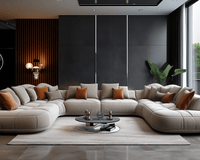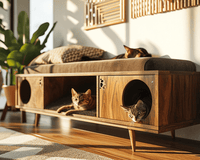Introduction:
Building your own TV stand can be a rewarding and cost-effective project that adds a personal touch to your home decor. In this step-by-step guide, we will walk you through the process of creating a customized TV stand. From selecting materials to the final finishing touches, follow along to build a stylish and functional piece of furniture.

Planning Your TV Stand
1.1 Determining Dimensions
Determining the dimensions of your TV stand is a crucial aspect of building a piece of furniture that not only accommodates your television but also fits well in your living space. Here's a step-by-step guide on how to determine TV stand dimensions:
- Measure Your TV:
Begin by measuring the width, height, and depth of your TV. These measurements will be the foundation for determining the size of your TV stand.
Consider leaving some extra space around the TV to avoid a cramped look. This extra space is not only for aesthetics but also for ventilation.
- Consider TV Placement:
Decide where you want to place your TV stand in the room. Take into account factors like the height of seating areas, viewing angles, and any potential obstructions.
Ensure that the TV stand's height is comfortable for viewing from your preferred seating arrangement.
- Room Size and Layout:
Evaluate the size of the room where the TV stand will be located. Consider the overall layout and available space. Ensure that the dimensions of the TV stand are proportionate to the room size. A balance between the size of the TV stand and the available space is essential for a harmonious look.
- Storage Requirements:
If your TV stand will have storage features like shelves or cabinets, consider what items you want to store in them. Measure the dimensions of these items to ensure that the storage spaces are appropriately sized.

1.2 Choosing Materials
Choosing materials when making a DIY TV stand is crucial to creating a sturdy, beautiful, and functional piece of furniture. Here is a guide on how to choose the materials to make your TV stand:
- Determine the design and style:
Determine the design and style of the TV stand, whether it is modern, rustic, or traditional. This will guide you in choosing materials and finishes.
- Choose the type of wood:
Choose the type of wood based on your preferences and budget. Options include hardwoods such as oak or maple, softwoods such as pine, versatile plywood, or affordable MDF.
- Consider quality and budget:
Invest in high-quality materials within your budget. Consider cost durability to ensure that the TV stand is sturdy and meets your requirements.
- Choose the finish and look:
Decide on the finish and look you want for your TV stand. Consider whether you prefer a natural wood finish, a stained look, or a painted finish, and choose materials accordingly.
- Ensure weight-bearing capacity and compatibility:
Ensure that the chosen material can withstand the weight of the TV and other components. Select hardware and fasteners that are appropriate for the chosen material and consider their ease of use.

1.3 Sketching the Design
- Measuring and planning:
Begin by measuring the dimensions of the TV set and consider where the TV cabinet will place in the room. Determine the overall dimensions, width, height, and depth. Plan extra space for aesthetics, ventilation, and any storage features. Consider the proportions of the room and the visual balance required to ensure the TV cabinet complements the overall layout.
- Sketch the design:
Sketch the TV cabinet design using the measurements collected. Outline the basic structure, including shelves, storage compartments, and decorative elements.
Indicate the overall height of the TV stand to ensure it is consistent with a comfortable viewing angle. Include any additional features you'd like to incorporate, such as cable management solutions or built-in lighting.
- Adjustments and refinements:
Review the initial sketches and make any necessary adjustments. Consider the practicality of the design to ensure that it meets your storage needs while complementing the aesthetics.
If possible, incorporate feedback from others to refine the sketch and finalize the design. Include specific measurements and details to guide you during the construction phase.

Gathering Materials and Tools
2.1 Essential Tools
Before getting your hands on your DIY TV stand, make sure you have the following essential tools on hand:
Measuring Tools:
Tape measure for accurate measurement of dimensions.
Combination square ruler to ensure the angles are correct.
- Cutting Tools:
Circular or miter saw for precise cuts.
Jigsaw for curved or intricate cuts.
Hand saws for smaller cuts or fine tuning.
- Joinery tools:
Electric drill with bit, for drilling holes.
Screwdriver or cordless screwdriver for assembling parts.
Wood glue, for secure joints.
- Finishing tools:
Sandpaper or power sander, for smoothing surfaces.
Wood filler, for filling gaps or imperfections.
Paint brush or sprayer, for applying finishes.
- Safety equipment:
Safety glasses for eye protection.
Ear protection if using loud power tools.
Dust mask for respiratory protection.

2.2 Selecting Wood or Other Materials
Choosing the right material is critical to the durability and aesthetics of your TV stand. Please consider the following points:
- Type of wood:
Hardwoods: Oak, maple and walnut for durability and a classic look.
Softwoods: Pine and cedar for affordability.
Plywood: Multi-layer panels for stability.
Medium Density Fiberboard (MDF): Engineered wood with a smooth finish.
- Quality and finish:
Choose quality wood for strength and longevity.
Choose a finish that complements the style of the room - natural wood, stain or paint.
Edging (if using plywood or MDF): Optional, but it makes exposed edges look more sophisticated.
2.3 Purchasing Hardware
Choosing the right hardware is critical to ensuring structural integrity and functionality:
- Screws and Fasteners:
Select screws of the proper length and size for the wood selected.
Confirm that the necessary nuts, bolts and washers are available.
- Drawer slides and hinges (if applicable):
Select quality slides for smooth drawer operation.
Cabinet door hinges should have the desired opening angle.
- Casters or feet (if mobility is required): Make sure they can handle the weight of the TV cabinet and provide the desired height.
- Decorative hardware (optional): Consider using handles or knobs that complement the overall design.

Cutting and Preparing the Pieces
3.1 Measuring and Marking
Accurate measurements and markings are crucial for precise cuts and a well-fitted TV stand. Follow these steps:
- Measure Twice, Cut Once:
Double-check all measurements before making any cuts to avoid errors.
- Use the Right Marking Tools:
Utilize a pencil for visible markings on the wood.
Use a combination square or straight edge for straight lines.
- Mark Joinery Points:
Mark where joints, cuts, or holes need to be made.
- Consider Wood Thickness:
Account for the thickness of the saw blade when marking dimensions.
3.2 Using Power Tools Safely
Safety is paramount when using power tools. Follow these guidelines:
- Wear Safety Gear:
Use safety glasses, ear protection, and a dust mask as appropriate.
- Read the Manuals:
Familiarize yourself with the user manuals for all power tools.
- Secure the Workpiece:
Use clamps or other secure methods to stabilize the wood.
- Maintain a Clean Workspace:
Remove debris to prevent accidents and ensure a clear view of your work.
- Follow Proper Technique:
Maintain a firm grip on tools, and use proper body mechanics to avoid strain.
- Disconnect Power:
Unplug power tools when changing blades or making adjustments.
3.3 Sanding and Smoothing
After cutting, it's essential to prepare the surfaces for a professional finish:
- Start with Coarse Grit:
Use coarse-grit sandpaper to smooth rough edges and remove imperfections.
- Progress to Finer Grits:
Gradually use finer grits for a smoother finish. This can include medium and fine sandpapers.
- Sand Along the Grain:
Always sand in the direction of the wood grain for a cleaner finish.
- Round Edges (if desired):
Use sandpaper to round sharp edges for safety and aesthetics.
- Remove Dust:
Wipe away sanding dust using a clean cloth or tack cloth before applying finishes.
- Inspect for Imperfections:
Inspect the wood for any remaining imperfections and address them before finishing.

Assembling the Frame
4.1 Joining Techniques
- Common Joining Techniques:
Butt joints, mitered joints, and mortise and tenon joints are common choices.
Pocket mortise and tenon may also be considered for added strength and simplicity.
- Select the appropriate joining method based on design:
Select the proper joining technique based on design and aesthetic preference
4.2 Securing Joints
Ensuring a strong connection is critical to the stability and durability of your TV stand:
- Use quality hardware:
Purchase screws, nails, or dowels that meet strength requirements.
Make sure the screws are the right length to provide adequate support.
- Apply wood glue:
Apply wood glue liberally to joints for added strength.
Wipe off excess glue before it dries to avoid uneven finishes.
4.3 Checking for Stability
Check the stability of the assembled frame before proceeding to the next stage:
- Test the joints and connections:
Gently shake the frame to locate loose connections. Tighten screws or make adjustments as needed.
- Make sure it is level and square:
Use a level to confirm that the TV stand is balanced. Check verticality to avoid an uneven appearance.

Adding Shelves and Storage
5.1 Determining Shelf Placement
Effective shelf placement enhances functionality and aesthetics:
- Consider component height:
Plan shelf heights based on the size of media components. Allow extra space for large equipment or decorative items.
- Maintain visual balance:
Place shelves evenly to ensure aesthetics.
5.2 Installing Shelves Securely
Firmly mounting the shelves will prevent sagging and increase the stability of your TV stand:
- Use proper support:
Use shelf brackets or cleats for added support. Consider using adjustable shelf brackets for versatility.
- Check if shelves are level:
Use a level to verify that shelves are installed evenly. Make adjustments as necessary to avoid tilting.
5.3 Incorporating Storage Solutions
Customize your TV cabinet to fit your storage needs:
- Consider closed and open storage:
Plan to combine closed cabinets and open shelves. Integrate drawers or baskets for hidden storage.
- Cable Management:
Design openings or channels for neat cable management. Make sure electrical outlets are easy to access.
Finishing Touches
6.1 Choosing a Finish
Choosing the right finish can both enhance the aesthetics and protect the wood:
- Natural wood finishes:
Using a clear finish accentuates the natural beauty of the wood.
Use a wood conditioner before staining to obtain an even finish.
- Paint:
Use paint to customize the color to match the trim.
Prime the wood for a smooth, durable painted finish.
6.2 Staining or Painting
Apply stain or paint in a well-ventilated area:
- Follow the instructions for use:
Apply the stain or paint evenly with a brush or sprayer.
Allow sufficient drying time between coats.
- Sanding between coats:
Lightly sand the surface with sandpaper between coats to make it smooth.
Wipe off dust before applying subsequent coats.
6.3 Use a suitable sealant to protect the TV cabinet:
- Clear Sealer:
Apply a clear sealer to protect the finish from abrasion.
Consider using a water-based sealer to protect the environment.
- Polyurethane or Varnish:
Apply polyurethane or varnish for added durability.
Follow the manufacturer's instructions to determine the number of coats required. Sealing the Surface
Mounting the TV
7.1 Ensuring Proper Alignment
Ensure the TV is securely mounted and aligned with the TV stand:
- Use Compatible Mounts:
Select a TV mount that is compatible with your TV's size and weight.
Follow the manufacturer's guidelines for installation.
- Double-Check Alignment:
Confirm that the TV is centered and aligned with the stand.
Adjust the mount as necessary.
7.2 Concealing Wires
Create a clean and organized appearance by concealing wires
- Use Cable Management Systems:
Install cable management solutions such as clips or channels.
Route wires behind the TV stand for a tidy look.
7.3 Testing Stability
Before finalizing the setup, ensure the TV stand is stable and secure
- Perform Stability Tests:
Gently shake the TV stand to check for any wobbling or instability.
Recheck all joints, screws, and connections for tightness.

Conclusion:
Ready to transform your entertainment space with a custom TV stand? Gather your materials, grab your tools, and begin the journey of creating a TV stand that reflects your style and meets your storage needs. The satisfaction of making your furniture is just around the corner!
FAQs (Frequently Asked Questions)
Q1: What are the recommended wood types for building a sturdy TV stand?
A1: Common choices include hardwoods like oak, maple, or birch for durability.
Q2: Can I customize the design to fit my specific TV size?
A2: Absolutely! Adjust the dimensions in the planning stage to accommodate your TV.
Q3: Is it necessary to use power tools, or can I build a TV stand with hand tools only?
A3: While hand tools can be used, power tools often make the process more efficient.
Q4: How do I prevent my TV stand from tipping over?
A4: Ensure the stand is properly balanced, and consider anchoring it to the wall for added stability.
Q5: What's the best way to hide cables and wires behind the TV stand?
A5: Incorporate cable management solutions, such as built-in channels or clips, during assembly.













